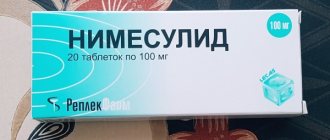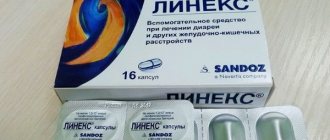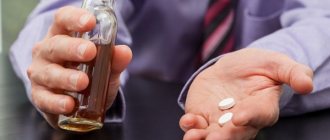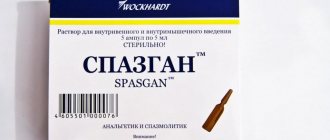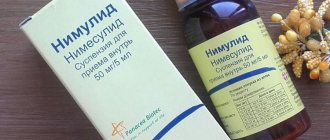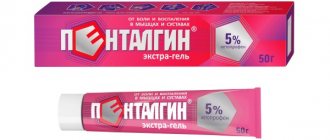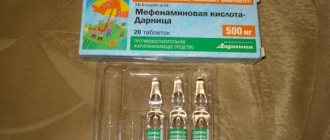Release form and composition
The drug is produced in the form of granules for the preparation of a suspension for oral administration: round and irregularly shaped granules from rich to pale yellow in color with yellow inclusions, with the smell of orange; the presence of a yellow to pale yellow powder with yellow inclusions is possible (2 g each in a heat-sealable bag made of combined packaging material; in a cardboard box there are 5, 10, 20 or 30 bags and instructions for use of Nimesulide-MBF).
2 g of the drug (contents of 1 package) include:
- active substance: nimesulide – 0.1 g (100% of the substance);
- additional components: macrogol glyceryl hydroxystearate, sucrose (sugar), maltodextrin, citric acid, orange flavor.
"NIMESULIDE": composition
The active component - nimesulide - is a non-narcotic analgesic of the non-steroidal sulfonamide group, which has anti-inflammatory and antipyretic effects.
Sold in the form of granular powder intended for preparing a suspension. The granules are packaged in sachets in a dosage of 2 milligrams. The box contains instructions for using nimesulide powder.
How does it affect the body? (Pharmacodynamics)
The active ingredient of the drug belongs to the group of non-steroidal anti-inflammatory drugs. It blocks the production of prostaglandins in the body - chemical compounds that accompany any inflammatory process.
Prostaglandins, acting in the brain, are responsible for:
- stimulation of the temperature regulation center located in the hypothalamus, which causes an increase in temperature.
- increased sensitivity of receptors to histamine and bradykidine, which are pain mediators. Both substances are produced during the inflammatory process, connect to specific receptors, as a result of which a person experiences pain.
When the amount of prostaglandins decreases, the temperature drops to normal, the pain either goes away or weakens.
The drug reduces the severity of the local inflammatory process, removes morning stiffness characteristic of rheumatoid arthritis, and reduces pain at rest.
When entering the body through the esophagus, the active substance is quickly absorbed into the blood through the walls of the gastrointestinal tract. 2-3 hours after administration, the maximum concentration of nimesulide in the blood occurs.
The substance is distributed throughout the body, penetrating the blood-brain barrier into the synovial fluid (43%) and the site of inflammation (up to 40%). The main part of the metabolism of the substance takes place in the liver. Excretion from the body occurs through the kidneys and urinary system and with bile.
Pharmacological properties
Pharmacodynamics
Nimesulide-MBF is an NSAID that has anti-inflammatory, antipyretic, analgesic and antiplatelet effects. In contrast to other NSAIDs, it selectively inhibits cyclooxygenase-2 (COX-2) and blocks prostaglandin production at the site of inflammation. It demonstrates a less pronounced inhibitory effect on COX-1 and less often leads to undesirable effects associated with inhibition of prostaglandin production in healthy tissues.
Pharmacokinetics
After oral administration of Nimesulide-MBF, high absorption of the active substance is observed. Eating reduces the rate of absorption, but does not affect its extent. The period to reach maximum concentration (TCmax) is 1.5–2.5 hours. Most of the drug (95%) binds to plasma proteins, and only 2% to erythrocytes, and 1% each to lipoproteins and acidic alpha1-glycoproteins. The degree of binding is independent of dose changes. The maximum concentration (Cmax) is 3.5–6.5 mg/l, volume of distribution (Vp) is 0.19–0.35 l/kg. The drug easily penetrates into the tissues of the genital organs of women, in which after a single dose its content is approximately 40% of the plasma level. It accumulates well in synovial fluid (43%) and the acidic environment of the inflammation site (40%), and easily passes through histohematic barriers.
The process of metabolic transformation occurs in the liver with the participation of tissue monooxygenases. The main metabolite of nimesulide is 4-hydroxynimesulide (25%), which has similar pharmacological activity, but as a result of a decrease in molecular size, it can quickly diffuse through the hydrophobic COX-2 channel to the active binding site of the methyl group. 4-Hydroxynimesulide is a water-soluble compound for the excretion of which glutathione and the development of conjugation reactions of phase II metabolism (glucuronidation, sulfation and others) are not required.
The half-life (T1/2) of the active substance is 1.56–4.95 hours, and its main metabolite is 2.89–4.78 hours. 4-Hydroxynimesulide is excreted in the bile (35%) and kidneys (65%). and undergoes enterohepatic recirculation.
"NIMESULIDE" (powder): price
Today, the granular preparation is sold under the trade names “Nimesil”, “Nemulex”, “NIZE”. The medicine is sold according to a doctor's prescription. The price of nimesulide powder depends on several factors - the manufacturer, the size of the pharmacy markup, and the remoteness of the region. So, for example, 30 sachets of 2 mg powder will cost:
- ru – from 502 rubles;
- "Yuteka" - from 437 rubles;
- “Rigla” – from 567 rubles;
- “Doctor Stoletov” – from 719 rubles;
- Pharmacy chain “36.6” – 660 rubles.
Indications for use
Nimesulide-MBF is recommended for use for symptomatic treatment, reduction of inflammation and pain at the time of use for the following diseases/conditions:
- osteoarthritis (osteoarthritis), accompanied by pain (symptomatic therapy);
- acute pain, including pain in the musculoskeletal system, including bruises, dislocations of joints, sprains; lower back and back pain, bursitis, tendinitis; toothache;
- primary algodismenorrhea.
Nimesulide-MBF is recommended for therapy as a second-line drug.
What does NIMESULIDE help with? (powder)
The drug is prescribed for the following diseases and conditions:
- Acute pain in the back, lumbar region. Painful sensations can be triggered by inflammatory processes of soft tissues, joints, post-traumatic changes and systemic diseases;
- Pathologies of the musculoskeletal system accompanied by pain syndromes. Osteoporosis, osteochondrosis, inflammation of nerve endings, intramuscular inflammation, arthritic and arthrosis changes, consequences of autoimmune diseases, postoperative pain.
- Injuries, dislocations, sprains . Pain during recovery and rehabilitation.
- Toothache . Damage to the pulp and nerve as a result of the action of bacterial microflora or mechanical destruction of the tooth.
- Tendenitis, bursitis . Pain caused by inflammation.
- Osteoarthritis. Combined disease of bone tissue and joints.
- Algomenorrhea.
Contraindications
- erosive-ulcerative and inflammatory diseases of the gastrointestinal tract;
- bleeding in the gastrointestinal tract;
- bronchial asthma,
- individual intolerance to the components of the drug
- ulcerative colitis;
- cerebrovascular bleeding, etc.;
- hemophilia;
- Crohn's disease;
- polyposis;
- bleeding disorders
- kidney and liver pathologies;
- renal failure;
- heart failure,
- hyperkalemia;
- pregnancy,
- age up to 12 years,
- postoperative state of coronary artery bypass grafting.
Side effects
In case of high individual sensitivity to the active substance or an overdose of granules, adverse reactions may occur in the form of:
- poor sleep, nervous conditions, headaches, dizziness;
- rash, itching, erythema, dermatitis, excessive sweating, Stevens-Johnson syndrome, etc.
- problems with urination, oliguria, dysuria, renal failure, nephritis;
- nausea, vomiting, constipation/diarrhea, flatulence, gastritis, cholestasis, bleeding from the gastrointestinal tract, ulcerative formations on the walls of the stomach, epigastric pain, jaundice, hepatitis;
- anemia, hemorrhage, purpura, prolonged bleeding;
- shortness of breath, spasms in the bronchi, bronchial asthma.
- blurred vision.
- frequent heartbeat, low blood pressure, general weakness.
Special instructions for the use of granulated powder are to prescribe it with caution to patients with hereditary intolerance to fructose, glucose or sucrose, which are contained in this form of the drug.
Contraindications
Absolute:
- severe heart failure;
- severe dysfunction of blood clotting;
- liver failure or any active liver disease;
- severe renal failure, with creatinine clearance (CC) < 30 ml/min, diagnosed hyperkalemia;
- indications in the anamnesis of cerebrovascular bleeding or other lesions that occur with increased bleeding;
- suspicion of acute surgical pathology;
- febrile syndrome due to colds and acute respiratory viral infections (ARVI);
- active phase of gastric or duodenal ulcer; erosive and ulcerative defects of the gastrointestinal tract (GIT); history of gastrointestinal bleeding or perforation;
- chronic inflammatory bowel diseases (ulcerative colitis, Crohn's disease) during exacerbation;
- history of hepatotoxic reactions to the use of nimesulide;
- combination therapy with other drugs with potential hepatotoxicity (including other NSAIDs);
- complete or partial combination of recurrent polypous rhinosinusitis, bronchial asthma with intolerance to acetylsalicylic acid or any other NSAIDs (including medical history);
- rhinitis, urticaria, bronchospasm or other hyperergic (severe) reactions in history caused by the use of acetylsalicylic acid or NSAIDs, including nimesulide;
- the period after coronary artery bypass surgery;
- alcoholism, drug addiction;
- lactase deficiency, glucose-galactose malabsorption, hereditary lactose intolerance;
- glucose-galactose malabsorption syndrome and sucrase-isomaltase deficiency, hereditary fructose intolerance;
- pregnancy and lactation;
- age up to 12 years;
- hypersensitivity to any of the components included in the drug.
Relative (it is necessary to take the suspension prepared from Nimesulide-MBF granules with caution):
- coronary heart disease (CHD); compensated heart failure; cerebrovascular diseases;
- peripheral arterial lesions;
- arterial hypertension;
- hemorrhagic diathesis;
- functional kidney damage (with CC 30–60 ml/min);
- diabetes;
- dyslipidemia/hyperlipidemia;
- smoking;
- history of Helicobacter pylori infection;
- history of erosive and ulcerative lesions of the gastrointestinal tract;
- severe somatic diseases;
- long-term previous NSAID therapy;
- elderly age;
- combined use with the following drugs (due to increased risk of ulceration or bleeding): antiplatelet agents (clopidogrel, acetylsalicylic acid), anticoagulants (warfarin), selective serotonin reuptake inhibitors (SSRIs) (paroxetine, fluoxetine, citalopram, sertraline), oral glucocorticosteroids (GCS) ) (prednisolone).
Nimesulide-MBF, instructions for use: method and dosage
The suspension prepared from Nimesulide-MBF granules is taken orally.
The drug in the amount of 2 g (contents of 1 sachet) should be diluted in 100 ml of water at room temperature to form a white suspension with a yellow-gray tint. The resulting solution cannot be stored.
Adults and adolescents over 12 years of age are recommended to take a suspension prepared from 2 g of granules (1 sachet) 2 times a day after meals. The maximum daily dose is 0.2 g of nimesulide, which is equivalent to the contents of 2 packets. The maximum course of treatment is 15 days.
In order to reduce the risk of side effects, it is recommended to use the lowest effective dose of Nimesulide-MBF for the shortest possible period.
"NIMESULIDE": analogues
The following medications can be used as direct analogues:
“Nise” - granules for preparing a suspension from Indian pharmaceutical production. The active component is the same NSAID as in Nimesil. Sold in packages of 9 sachets of 100 mg. Price – 243 rubles.
"Nimesil" is a European drug based on nimesulide. Used as an analgesic of the NSAID group in the treatment of acute muscle, dental and symptomatic pain. Price – 660 rubles.
“Nemulex” is a granular soluble powder in sachets of 10 pieces with a dosage of 100 mg. It has an analgesic and anti-inflammatory effect based on the same active component. Price – from 177 rubles.
Side effects
- respiratory system: infrequently – shortness of breath; extremely rarely – bronchospasm, exacerbation of bronchial asthma;
- cardiovascular system: infrequently - increased blood pressure (BP); rarely - a feeling of palpitations, a rush of blood to the skin of the face, lability of blood pressure, tachycardia;
- immune system: rarely – hypersensitivity reactions; extremely rarely - anaphylactoid reactions;
- blood and lymphatic system: rarely - hemorrhages, anemia, eosinophilia; extremely rarely - thrombocytopenic purpura, pancytopenia, thrombocytopenia;
- nervous system: infrequently – dizziness; extremely rarely - drowsiness, headache, encephalopathy (Reye's syndrome);
- organ of vision: rarely – blurred vision; extremely rarely - visual impairment (taking Nimesulide-MBF should be stopped immediately and an ophthalmological examination should be prescribed);
- organ of hearing and labyrinthine disorders: extremely rarely – vertigo;
- mental disorders: rarely – nightmares, feelings of fear, nervousness;
- water-electrolyte metabolism: rarely – hyperkalemia;
- skin and subcutaneous tissues: uncommon – skin rash, itching, increased sweating; rarely – dermatitis, erythema; extremely rarely - facial swelling, urticaria, erythema multiforme, angioedema, toxic epidermal necrolysis (Lyell's syndrome), Stevens-Johnson syndrome;
- kidneys and urinary tract: rarely - hematuria, dysuria, urinary retention; extremely rarely - oliguria, renal failure, interstitial nephritis;
- liver and biliary tract: often - increased activity of liver enzymes; extremely rarely - cholestasis, jaundice, fulminant hepatitis, including death;
- Gastrointestinal tract: often - nausea, diarrhea, vomiting; uncommon – flatulence, constipation, gastritis, ulcer and/or perforation of the stomach or duodenum, gastrointestinal bleeding (in this case, therapy should be stopped immediately); extremely rarely - stomatitis, dyspepsia, abdominal pain, tarry stools;
- other: infrequently - peripheral edema; rarely – asthenia, malaise; extremely rarely - hypothermia.
Overdose
Symptoms of an overdose of Nimesulide-MBF may include: drowsiness, apathy, nausea, vomiting, epigastric pain. These effects are usually reversible with symptomatic and supportive treatment. It is also possible to increase blood pressure, develop gastrointestinal bleeding, acute renal failure, respiratory depression, coma, and anaphylactoid reactions.
A specific antidote is unknown. If signs of nimesulide intoxication appear, symptomatic and supportive therapy is prescribed. If an overdose has occurred within the last 4 hours, vomiting should be induced and/or activated charcoal should be used (60–100 g for an adult) and/or an osmotic laxative. Due to the significant binding of the drug to plasma proteins, hemodialysis, hemoperfusion, forced diuresis and urine alkalization are ineffective. It is necessary to monitor the patient's renal and liver function.
"NIMESULIDE": reviews
This is an excellent drug, proven and affordable. It turned out to be especially effective for back pain. We rarely have deliveries at our pharmacy and it’s not always possible to buy tablets, but the powder is almost always available. My back has been hurting constantly for several years now. Of course, I was treated several times and went to the center for diagnostics. They prescribed many different pills and courses. And in an emergency, only Nimesulide always helps.
Perhaps the most affordable remedy from the “first aid” series for any pain. I use it for toothache. Naturally, it’s not just like that - I buy it in powder and dilute it into a suspension. This way he starts to act faster. In addition, you can adjust the dosage yourself. This is a very beneficial medicine. I always have it in my medicine cabinet. Just in case.
special instructions
There are isolated reports of extremely rare episodes of serious reactions from the liver, including fatal ones, caused by the use of drugs containing nimesulide. If symptoms similar to signs of liver damage occur, such as itching, anorexia, yellowing of the skin, abdominal pain, nausea, vomiting, darkening of urine, increased activity of liver transaminases, it is necessary to immediately stop treatment with the drug and consult a doctor. For patients in this risk group, repeated use of Nimesulide-MBF is contraindicated.
With short-term use of Nimesulide-MBF, the observed reactions from the liver were in most cases reversible.
During therapy, you should refrain from using other analgesics, including NSAIDs (including selective COX-2 inhibitors).
Nimesulide-MBF must be used with extreme caution if there is a history of gastrointestinal lesions (ulcerative colitis, Crohn's disease), due to the increased likelihood of exacerbation of these diseases.
The threat of gastrointestinal bleeding, peptic ulcer/perforation of the stomach or duodenum is aggravated in patients with a history of gastrointestinal ulcers, as well as in elderly people with an increase in the dose of NSAIDs. As a result, treatment should begin with the lowest possible dose. Such patients, as well as patients receiving acetylsalicylic acid in low doses, or other drugs that increase the risk of developing gastrointestinal disorders, are recommended to additionally use gastroprotectors (proton pump blockers, misoprostol).
Patients with a history of gastrointestinal lesions and elderly patients should inform the doctor about any new symptoms in the digestive tract, and especially about phenomena that may indicate possible gastrointestinal bleeding.
If the first signs of damage to the mucous membranes, skin rash or other allergic reaction occur, drug therapy should be stopped immediately.
Since Nimesulide-MBF can lead to fluid retention, it is recommended to take it with extreme caution in the presence of arterial hypertension with renal and/or heart failure.
If signs of a cold or acute respiratory viral infection appear during treatment with the drug, its use should be stopped.
Nimesulide can affect platelet function, as a result of which the drug must be used with caution in patients with hemorrhagic diathesis, but it should be remembered that the drug cannot replace the preventive effect of acetylsalicylic acid in cardiac diseases.
Nimesulide-MBF contains sucrose (0.15–0.18 bread units per 100 mg), this should be taken into account by patients with diabetes mellitus and those on a low-calorie diet.
Impact on the ability to drive vehicles and complex mechanisms
During the period of therapy, it is recommended to be careful when driving a car and other complex mechanisms, as well as when performing other types of work that require increased attention and speed of reactions.
Instructions for Nimesulide
Tablets and granules are for oral administration only. The gel can be applied to the skin at the site of pain. Granules should be added to clean water in a volume of eighty to one hundred milliliters. For patients from twelve to eighteen years of age and adults, it is advisable to take one hundred milligrams of the substance no more than twice a day after meals. No more than two hundred milligrams per day. Elderly patients can take the same dosage. If there is impaired renal function, it is advisable to reduce the daily dose to one hundred milligrams.
It is better to entrust the doctor with dosage selection and therapy control
Should not be taken for longer than fifteen days. It is necessary to take the smallest dosage for a short amount of time to reduce the likelihood of complications. If any adverse reactions occur, you should stop therapy and consult a doctor.
Additional Information
- If the patient accidentally swallows a large dose, you should seek medical help as soon as possible. Severe complications may occur from the digestive system, heart, blood vessels, liver tissue, liver and other organs. These are liver damage, impaired renal function, hemorrhage in the gastrointestinal tract, increased blood pressure, respiratory failure and other unpleasant effects.
- You should definitely consult your doctor about medications you take with the drug, as dangerous interaction reactions sometimes occur. Nimesulide interacts with drugs that disrupt coagulation, antibiotics, corticosteroids and other groups of drugs. All possible effects of mutual use are described in the official instructions.
- The medication should be stopped immediately in the following cases: hemorrhage in the digestive tract, allergies, increased activity of enzymes of liver origin, kidney damage according to laboratory or symptomatic indicators, increased body temperature, vomiting and abdominal discomfort, dark coloration of urine, ulceration of the gastrointestinal tract. If there is a risk of such complications, treatment is controlled by a doctor.
- If the patient takes the drug for more than two weeks according to indications, it is necessary to discuss with a specialist the possibility of monitoring the condition of the organs, including regular blood tests. Elderly patients constantly need therapy monitoring.
- The degree of binding of the active component to plasma proteins decreases with liver damage, impaired renal function, decreased albumin levels and increased bilirubin levels.
- The use of the medicine can cause temporary infertility in patients, so therapy is not carried out during the planning period for conception.
- If undesirable effects on the brain and nervous system as a whole occur while taking the medication, you should refrain from hazardous activities such as driving.
Full instructions with detailed information are included in the packaging.
Use in old age
When treating elderly patients, the attending physician may adjust the daily dose, taking into account the possibility of interaction of nimesulide with other drugs received.
In older adults, the risk of adverse reactions to NSAIDs increases, including life-threatening gastrointestinal bleeding and perforation, as well as deterioration of the liver, kidneys and heart. When using Nimesulide-MBF in this category of patients, clinical monitoring is required.
Drug interactions
- anticoagulants (warfarin): the effect of these drugs is enhanced by NSAIDs; due to an increased risk of bleeding; this combination is not recommended and is contraindicated in severe coagulation disorders; if it is necessary to use these drugs in combination, careful monitoring of blood clotting parameters is required;
- GCS: increases the risk of developing gastrointestinal ulcers or bleeding;
- SSRIs, antiplatelet drugs: increases the risk of bleeding in the digestive tract;
- diuretics (furosemide): the effect of these drugs is reduced; nimesulide in healthy volunteers temporarily reduces sodium excretion under the influence of furosemide, and to a lesser extent potassium excretion, and also weakens the diuretic effect; combined use with nimesulide leads to a decrease in the area under the concentration-time curve (AUC) by approximately 20%, and a decrease in the cumulative excretion of furosemide, without causing changes in its renal clearance; when combining furosemide and nimesulide, caution should be exercised in patients with impaired renal/cardiac function;
- antihypertensive drugs: the effect of these drugs is weakened;
- angiotensin-II receptor antagonists, angiotensin-converting enzyme inhibitors: in case of mild/moderate renal failure (creatinine clearance 30–80 ml/min) against the background of a combination of these drugs with NSAIDs and other drugs that inhibit the COX system, further deterioration of kidney function and the appearance of acute renal failure, mostly reversible; Combined treatment should be carried out with extreme caution, especially in the elderly; After starting concomitant use, patients should consume sufficient fluids and monitor renal function;
- mifepristone: it is theoretically possible that the effect of mifepristone and prostaglandin analogues may be weakened as a result of the antiprostaglandin action of NSAIDs (including acetylsalicylic acid); According to the limited available data, the use of NSAIDs on the day of taking a prostaglandin analogue does not demonstrate a negative effect on the effect of the latter or mifepristone on uterine contractility and cervical dilatation, and does not reduce the clinical effect of medical termination of pregnancy;
- substrates of the CYP2C9 isoenzyme: the concentration of these drugs in plasma increases;
- lithium preparations: the clearance of lithium decreases, which leads to an increase in its plasma level and toxicity; monitoring of lithium content in blood plasma is necessary;
- methotrexate: an increase in the plasma concentration of this substance and, accordingly, an increase in its toxic effects is possible if nimesulide is taken less than 24 hours before or less than 24 hours after using methotrexate;
- Glibenclamide, digoxin, theophylline, cimetidine, aluminum and magnesium hydroxides: no clinically significant interactions observed;
- cyclosporines: their nephrotoxicity may increase due to the effect of prostaglandin synthesis inhibitors (including nimesulide) on renal prostaglandins.
